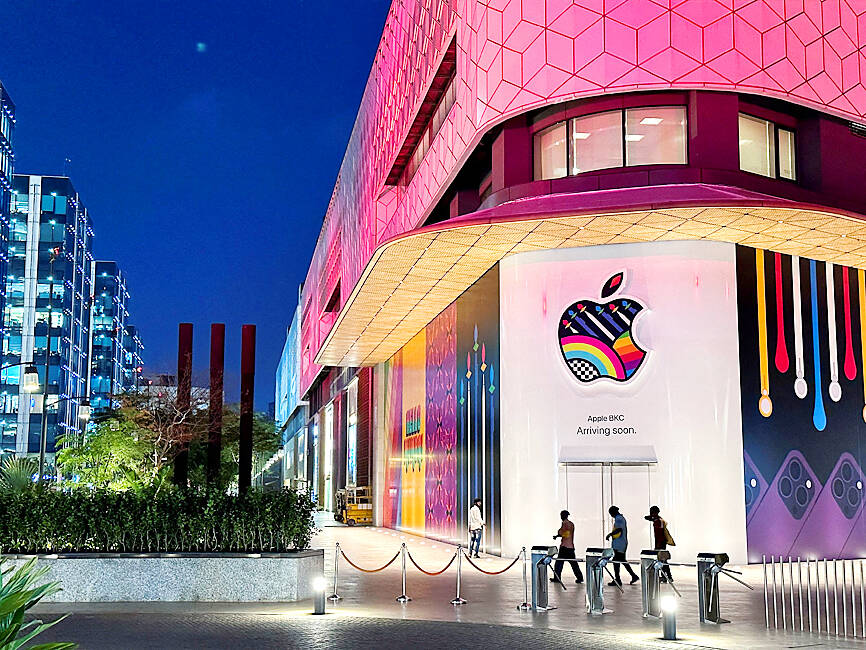Apple Inc’s sales in India hit a new high of almost US$6 billion in the year through last month, highlighting the market’s increasing importance for the iPhone maker as chief executive officer Tim Cook arrives in the country to open its first local stores.
Revenue in India grew by nearly 50 percent, from US$4.1 billion a year earlier, said a person familiar with the matter, who asked not to be named as the information is not public.
Apple is scheduled to post quarterly earnings on May 4 and has signaled it expects total global revenue to decline.

Photo: Reuters
Cook is set to inaugurate India’s first Apple stores this week, seeking to accelerate growth in a country of 1.4 billion where the company’s smartphones and computers have never held more than a minuscule market share due to their high cost.
With tech demand slowing globally, Apple has identified India’s expanding middle class as an attractive opportunity and it’s also adding local production at an increasing rate.
Apple, which has thus far relied on retail partners and online sales in India, did not respond to a request for comment.
The company launched its online store in India in 2020 and its sales drive is set for a boost as it opens its first local store today in an upscale business district in the financial hub of Mumbai. Two days later, it plans to open an outlet in the capital, New Delhi.
Apple’s India sales surged during the COVID-19 pandemic as customers bought iPhones and iPads to work and study from home. That momentum has continued, helped by financing and trade-in options.
Yet its base is small — just about 4 percent of India’s nearly 700 million smartphone users have iPhones — as the world’s second-biggest mobile market is led by cheaper local brands as well as Chinese and South Korean manufacturers.
However, the Cupertino, California-based company ranked No. 1 in unit sales of devices above US$365 last year, Counterpoint Technology Market Research said.
Apple’s stores serve as key retail and showcase points for the world’s most valuable company, while also often becoming tourist hot spots. Critically, the new India stores would also double as support centers, a potential selling point because it makes product returns and repairs easier.
The company does not break out India revenue in its earnings statements, but it is required to report annual sales in the country to local authorities. For the year through March last year, it posted sales of 333.8 billion rupees (US$4.07 billion).
While that is less than 2 percent of Apple’s global revenue, the market’s significance is growing and the company is also expanding its local manufacturing footprint. Apple tripled its production to more than US$7 billion of iPhones in India last fiscal year, part of an effort to reduce its reliance on China as tensions between Washington and Beijing continue to escalate.
Cook’s India push also means braving risks such as the country’s notoriously high import duties for everything from components to finished products, which affect retail prices and demand.
India is also known for sudden shifts in rules and regulations, which can expose companies to unexpected costs. Yet the market’s growth potential makes it difficult to ignore.
“India is a hugely exciting market for us and is a major focus,” Cook said during an earnings call in February. “We’re putting a lot of emphasis on the market.”

Taiwan Semiconductor Manufacturing Co (TSMC, 台積電) yesterday said that its investment plan in Arizona is going according to schedule, following a local media report claiming that the company is planning to break ground on its third wafer fab in the US in June. In a statement, TSMC said it does not comment on market speculation, but that its investments in Arizona are proceeding well. TSMC is investing more than US$65 billion in Arizona to build three advanced wafer fabs. The first one has started production using the 4-nanometer (nm) process, while the second one would start mass production using the

‘SILVER LINING’: Although the news caused TSMC to fall on the local market, an analyst said that as tariffs are not set to go into effect until April, there is still time for negotiations US President Donald Trump on Tuesday said that he would likely impose tariffs on semiconductor, automobile and pharmaceutical imports of about 25 percent, with an announcement coming as soon as April 2 in a move that would represent a dramatic widening of the US leader’s trade war. “I probably will tell you that on April 2, but it’ll be in the neighborhood of 25 percent,” Trump told reporters at his Mar-a-Lago club when asked about his plan for auto tariffs. Asked about similar levies on pharmaceutical drugs and semiconductors, the president said that “it’ll be 25 percent and higher, and it’ll

When an apartment comes up for rent in Germany’s big cities, hundreds of prospective tenants often queue down the street to view it, but the acute shortage of affordable housing is getting scant attention ahead of today’s snap general election. “Housing is one of the main problems for people, but nobody talks about it, nobody takes it seriously,” said Andreas Ibel, president of Build Europe, an association representing housing developers. Migration and the sluggish economy top the list of voters’ concerns, but analysts say housing policy fails to break through as returns on investment take time to register, making the

CHIP BOOM: Revenue for the semiconductor industry is set to reach US$1 trillion by 2032, opening up opportunities for the chip pacakging and testing company, it said ASE Technology Holding Co (日月光投控), the world’s largest provider of outsourced semiconductor assembly and test (OSAT) services, yesterday launched a new advanced manufacturing facility in Penang, Malaysia, aiming to meet growing demand for emerging technologies such as generative artificial intelligence (AI) applications. The US$300 million facility is a critical step in expanding ASE’s global footprint, offering an alternative for customers from the US, Europe, Japan, South Korea and China to assemble and test chips outside of Taiwan amid efforts to diversify supply chains. The plant, the company’s fifth in Malaysia, is part of a strategic expansion plan that would more than triple